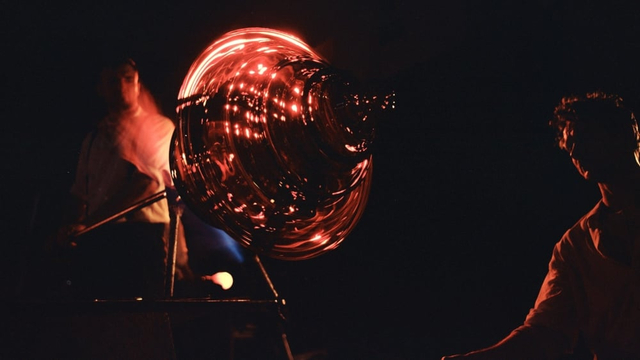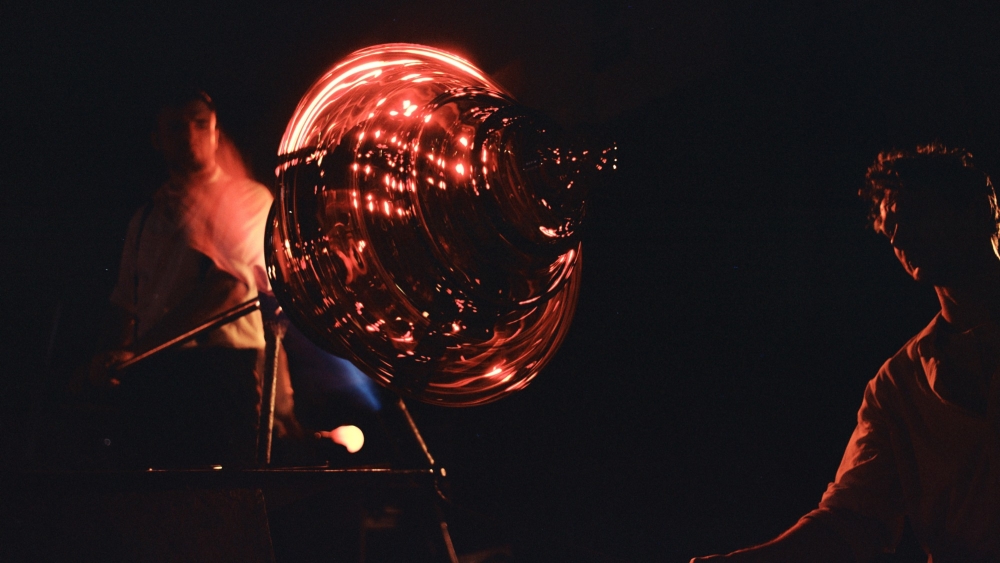
Inside the Making of Glass at Ajeto
Glass is as old as fire, yet it remains a site of progress and surprise. In Northern Bohemia, the craft has burned for over a thousand years, carried forward today in two very different worlds: the fiery creative soul of Ajeto’s hand-blown glass, and the immaculate precision of Lasvit’s fusing kilns. Together they show how a material of paradoxes continues to surprise us. This story begins with Ajeto.
Glass is a material of paradoxes. First it is liquid, then it is solid. It is strong yet fragile, heavy yet able to capture the lightest ray and let it shine through. Both ancient and modern, it embodies the transformation of earth, fire, air, and water, turning raw matter into something luminous. And for more than a thousand years, that transformation has been part of life in Northern Bohemia. In the hills and valleys of Crystal Valley, fire here has never gone out, carried from one generation to the next. These are the foundations Lasvit is built on, and here the spirit of glass is in good hands, supported by a deep appreciation for traditional methods and a commitment to cultivate them for the future. Quite symbolically, Lasvit’s headquarters stands in restored 18th-century timbered houses that once served as a glassmaking school – a reminder that education and continuity are as vital to the craft as fire itself. "Heat intuition and material sensitivity that can be acquired only by years of sweat and patience by the furnace." It was here in the Crystal Valley, where legendary designer Bořek Šípek, whose daring design defined an era, and his associates founded Ajeto in the early 1990s. Built on freedom, risk, and craftsmanship, Ajeto broke away from industrial repetition and became a place where artists, designers, and craftspeople could push the material to its limits. Artists such as Dale Chihuly and Marvin Lipofsky came here to test the limits of the material handled by some of the rarest skills in the field. The Tour de France trophy is born here each year, alongside daring works that have entered cultural history. Today, Ajeto is part of Lasvit, which continues to promote and protect the unique skills of Bohemian glassmaking. Rather than merely adhering to established techniques, Lasvit views its artisans as true artists, and glass as their playground for experimentation. "Handmade objects radiate creative and humanistic energy that can be felt even in complete darkness." Lasvit’s workshops are home to some of the most skilled artisans, where nearly every glass technique is practiced under one roof: mould-making, glassblowing, hot sculpting, flame working, casting, fusing, cold working, etching, sandblasting, gilding, engraving, and assembling. Artisans of Lasvit's own hot shop is one of the few glassworks that still mixes its own colors. Its sixpot furnace offers unparalled flexibility melting multiple glass types and colors at once, from pure crystal to experimental batches like uranium glass. "I close my eyes and visualize the final piece in three dimensions before I begin, ensuring accuracy and artistic intent throughout the process." At Ajeto, glassmakers move between intricate details and monumental works. Their physical strength and endurance make the largest pieces possible, yet it is their attention to detail that renders each work precise, refined, and visually effortless. Heritage in Ajeto is a living practice, passed from bench to bench and kept alive by the same fire that has never gone out. Tradition sets the standard, it does not set a limit, and each generation tests it again. From the old schoolhouses to the six pot furnace, skills are learned, refined, and tried in new ways. Every glassmaker is an artist, their hand leaves a quiet imprint that sits beside the lineage of the craft. The result is work that carries memory and momentum, faithful to where it comes from and open to what comes next. When Sand Goes to Heaven

Workers of the Fire that Has Been Burning for Millenia


Playground of Creation


Living Lineage
